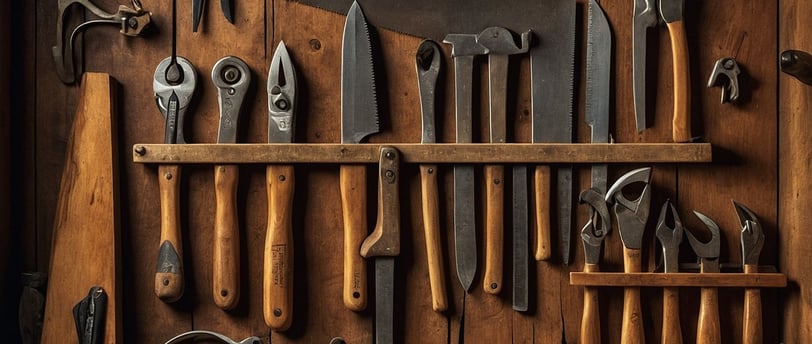Why Hand Tools Are Essential for Beginners
While power tools can make woodworking faster, hand tools are invaluable for beginners for several reasons:
Precision: Hand tools allow for more control, enabling you to make detailed cuts and adjustments.
Skill Development: Learning to use hand tools sharpens your woodworking skills and helps you understand the properties of wood.
Affordability: Hand tools are often more affordable than their powered counterparts, making them a cost-effective way to start your woodworking toolkit.
1. Hand Saw
A hand saw is one of the most basic and versatile tools you’ll use in woodworking. While power saws like circular or table saws are great for large cuts, a hand saw gives you control over detailed and precise cuts, whether you’re cutting straight lines or making quick rough cuts.
Types of Hand Saws:
Rip Saw: Designed to cut along the grain of the wood, perfect for making long, straight cuts.
Crosscut Saw: Used to cut across the grain for a cleaner finish on shorter cuts.
Back Saw: Equipped with a stiff spine for precise cuts, ideal for cutting joints like dovetails or tenons.
Why It’s Essential:
Precision and Control: Hand saws allow you to make precise cuts by hand, which is crucial when working on detailed projects like joints or fine woodworking.
Versatility: Whether cutting boards for a shelf or trimming small pieces of wood, a hand saw is suitable for almost any basic woodworking task.
Pro Tip: Keep your hand saw sharp by regularly maintaining the teeth, and practice using smooth, steady strokes for cleaner cuts.
2. Claw Hammer
A claw hammer is an indispensable tool in any woodworker's toolbox. Not only is it used to drive nails into wood, but the claw on the back is perfect for removing nails and prying apart joints when needed. A good-quality hammer will serve you well for everything from building furniture to simple repairs.
Types of Hammers:
Standard Claw Hammer: Features a curved claw for nail removal and a smooth head for hammering nails.
Framing Hammer: A heavier hammer with a straighter claw, often used for larger construction projects.
Why It’s Essential:
Driving and Removing Nails: Whether you're assembling wood frames or securing pieces together, a claw hammer helps drive nails flush with the surface of the wood.
Versatility: The claw is handy for removing nails, prying apart boards, or adjusting pieces during construction.
Pro Tip: Choose a hammer with a comfortable grip and a balanced weight that feels right in your hand to reduce fatigue during extended use.
3. Chisels
Chisels are vital for detailed wood carving, cleaning out joints, and fine-tuning your work. A set of sharp wood chisels will allow you to carve intricate details or make precise cuts in joints, such as mortise and tenon, dovetail, or lap joints.
Types of Chisels:
Bevel-Edge Chisels: Versatile chisels with angled edges, ideal for general-purpose woodworking and getting into tight corners.
Mortise Chisels: Heavier-duty chisels used for cutting strong, deep mortises.
Paring Chisels: Long, thin chisels designed for making delicate, precise cuts.
Why It’s Essential:
Precision Carving: Chisels allow you to remove small amounts of wood to create clean, sharp joints or intricate designs.
Versatile Use: From cutting mortises to refining edges and corners, chisels are useful for both rough cuts and fine detailing.
Pro Tip: Keep your chisels sharp with regular honing. A dull chisel requires more force and can lead to rough cuts or even accidents.
4. Marking Gauge
A marking gauge is a tool used to mark lines parallel to a wood's edge. It ensures your cuts, joints, and layouts are straight and consistent, which is crucial for professional-looking results. The marking gauge typically has a sharp pin or blade that scratches a line into the wood’s surface, offering more accuracy than a pencil mark.
Why It’s Essential:
Accurate Layouts: Whether you’re marking for cuts, mortises, or dovetails, the marking gauge helps ensure precision.
Consistency: The adjustable fence on the marking gauge allows you to make repeated marks with the same measurements, ensuring consistency across your project.
Pro Tip: Use a light touch when dragging the marking gauge across the wood to avoid deep scratches, which can be hard to remove later.
5. Block Plane
A block plane is a small, handheld tool used to smooth rough edges, flatten surfaces, and fine-tune the fit of joints. It's perfect for removing thin shavings of wood, which allows for precise adjustments to your project. Whether you're trimming doors, smoothing a tabletop, or chamfering edges, a block plane offers excellent control and a refined finish.
Why It’s Essential:
Smoothing Surfaces: A block plane is ideal for leveling uneven surfaces or trimming down wood without the need for sandpaper or power tools.
Fine-Tuning Joints: When creating joints like mortise and tenon, a block plane allows you to shave off small amounts of wood for a perfect fit.
Chamfering Edges: You can use a block plane to gently bevel or round off sharp corners for a smoother, safer finish.
Pro Tip: Always keep the blade sharp, and adjust the depth of the cut for precise control over how much material you remove.
Additional Tools to Consider
Once you’ve mastered the essentials, there are a few more hand tools that you might want to add to your collection:
Tape Measure: For accurate measurements of wood and spaces.
Try Square: Ensures your cuts and joints are at perfect 90-degree angles.
Mallet: Used for tapping chisels without damaging their handles.
These additional tools will make your woodworking projects easier and more precise as you progress.
How to Maintain Your Hand Tools
Your hand tools will last for years with proper care. Here are a few maintenance tips to keep them in excellent working condition:
Keep tools clean: After each use, wipe down your tools to remove dust and sap.
Sharpen blades: Tools like chisels and block planes need regular sharpening. A sharp blade not only works better but is safer to use.
Oil metal parts: Prevent rust by occasionally oiling metal parts, especially on tools like chisels and planes.
Conclusion
These top 5 essential woodworking hand tools will serve as the foundation of your woodworking toolkit. With a hand saw, claw hammer, chisels, marking gauge, and block plane, you’ll be able to tackle a wide range of beginner projects with confidence and precision. By investing in high-quality tools and learning how to use them properly, you’ll build skills that will last a lifetime, setting you on the path to becoming a skilled woodworker.
Whether you're crafting furniture, building small projects, or making repairs around the house, these tools will provide you with the versatility, accuracy, and control needed to create beautiful, lasting pieces.




